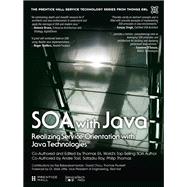-- Antonio Bruno, Enterprise Architecture and Strategy, digitalStrom
“A great self-contained book on SOA using flexible Java implementations....”
-- Roger Stoffers, Hewlett Packard
“Provides clarity on abstract concepts and is filled with concrete examples of implementing SOA principles in Java environments.”
-- Sanjay Singh, Certified SOA Architect
“...provides a holistic, comprehensive view on leveraging SOA principles and architecture for building and deploying performant Java services.”
-- Suzanne D’Souza, KBACE Technologies
“Thomas Erl’s series of books on services technology have shaped, influenced, and strengthened a whole community of enterprise and solution architects’ thinking and solution development, and the much awaited SOA with Java book is an excellent addition to the series. It is a must-read.”
-- Lalatendu Rath, Wipro Technologies
The Definitive Guide to Building Service-Oriented Solutions with Lightweight and Mainstream Java Technologies
Java has evolved into an exceptional platform for building Web-based enterprise services. In SOA with Java, Thomas Erl and several world-class experts guide you in mastering the principles, best practices, and Java technologies you need to design and deliver high-value services and service-oriented solutions.
You’ll learn how to implement SOA with lightweight frameworks, mainstream Java services technologies, and contemporary specifications and standards. To demonstrate real-world examples, the authors present multiple case study scenarios. They further demystify complex concepts with a plain-English writing style. This book will be valuable to all developers, analysts, architects, and other IT professionals who want to design and implement Web-based service-oriented architectures and enterprise solutions with Java technologies.
Topic Areas
- Applying modern service-orientation principles to modern Java technology platforms
- Leveraging Java infrastructure extensions relevant to service-oriented solutions
- Exploring key concepts associated with SOA and service-orientation within the context of Java
- Reviewing relevant Java platforms, technologies, and APIs
- Understanding the standards and conventions that REST and SOAP services are built upon in relation to Java implementations
- Building Java Web-based services with JAX-WS and JAX-RS
- Applying the eight key principles of service-orientation design using Java tools and technologies
- Creating Java utility services: architectural, design, and implementation issues
- Constructing effective entity services: service contracts, messages, data access, and processing
- Constructing task services, including detailed guidance on service composition
- Using ESBs to support infrastructure requirements in complex services ecosystems








